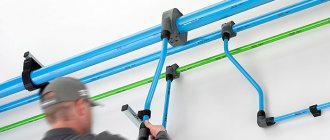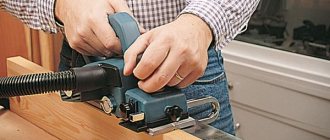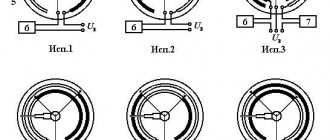When repairing roofing coverings, it is often necessary to use hot air and even fire: to melt bitumen, melt the underside of roofing felt, and even solder the edge of a metal sheet. And for this you already need special tools. But why not just set the same roofing felt on fire with a homemade torch if our goal is to melt the bitumen?
The fact is that you won't succeed this way. How do you direct the fire in the right direction, especially when there is wind? And how long will such torches last, since the work of laying the roof will be serious? These two main functions are performed by a gas burner. And now we’ll tell you how to choose it.
What are gas burners for roofing?
A gas burner is an indispensable thing when repairing a roof. It not only lays sheets of roofing felt, but also heats up the mastic and even seals small seams and holes. Here is a complete list of all operations:
- Cutting and soldering of metal elements.
- Removing the old layer of paint.
- Sealing small cracks.
- Melting mastic.
- Heating sheets before laying.
- Strengthening butt seams.
A typical roofing gas burner consists of a comfortable handle, a tube that supplies gas, and a metal cup at the end. A hose is connected to a special connector on the handle, and the required amount of gas is supplied to it from the cylinder. And you need to regulate the pressure through the valve on the reducer.
In practice, everything is simple: we press the handle lever, the gas enters the hose, and at the outlet of the glass, a combustion of a mixture of gas and air is formed, which we first ignite with a match. The flame temperature is so high that it can reach 1500°C! Using a valve, you can regulate not only the strength of the flame, but also its length.
Conventional gas burners are light enough - within 1-1.5 kg - so that you can easily hold them in your hand and not drop them from fatigue. And the role of the glass is precisely to shape the flow of flame in the desired direction. The design of the glass is precisely shaped in order to maximally protect the flame from being blown out by the wind. Moreover, both the glass and the handle are made differently for different burner models. Although they have the same operating principle: starting a gas burner is no more difficult than a kitchen burner - using an ordinary match or lighter.
Almost all modern gas burners for roofing provide a means of adjusting operating modes: standby mode and operating mode. The standby mode is designed specifically to save fuel.
Different models of modern gas burners differ from each other primarily in the principle of mixing air into the gas. Older burners are connected to an oxygen cylinder, while modern ones can take air from the atmosphere, which is more convenient, of course. Even the gas the burners use can vary. There, most often propane is used, but there are also units that run purely on methane. But we will also note other differences, based on which you can make the right choice.
Standard gas burner in action:
Stages of work when laying material using a roofing torch
If roofing felt is used as a waterproofing material, you cannot do without a gas burner. It is also necessary for covering the roof with modern built-up types of materials.
The entire process of working with the device can be divided into several stages.
- First you need to prepare the base for further laying of the material. For this purpose, it should be cleared of debris. If necessary, the surface must also be leveled using a concrete screed.
- After this, the rolled material is rolled out over the entire surface so that adjacent sheets form an overlap with a width of 85 to 90 mm.
- Having completed the leveling and markings, the rolls must be rolled up again and strengthened at the base of the roof using a torch. Heating the lower part of the roll and the base of the roof using a burner flame, the material is slowly rolled out, pressing it to the base.
To avoid the formation of wrinkles and air bubbles, you need to run a hand roller along the attached canvas. At the final stage of the work, a roofing gas burner is used to heat the seams of the overlapping material. After this, the seams should be rolled again using a hand roller.
When operating gas burners, you need to know several important points:
- The use of this device is possible at temperatures not lower than minus 15 degrees;
- if work is carried out at a lower temperature, then you can use a liquid fuel burner;
- when using a gas burner for laying roofing with high quality characteristics, from 500 to 600 m of roofing material can be laid per day;
- Since the work is carried out outdoors, the gas burner must provide a stable supply of flame and reliably protect it from being blown out by the wind.
Which is better quality: professional or budget?
So, professional contractors purchase usually expensive professional gas burners that are reliable and safe to use. But for a home craftsman, a small, convenient tool without any additional pretensions will be suitable for equipping and repairing the roof of your own home. Will the quality of work be worse? Not at all! It’s just that such a gas burner is not suitable for industrial work, where it is used almost every day and where uninterrupted processes and absolute safety come first.
It is also not acceptable to have a situation where a team goes to a new facility (and, of course, deadlines are definitely running out), and the burner is defective. There is neither time nor reserve to stop everything and go out to purchase new equipment. Whereas, with careful handling in the hands of a home craftsman, even the most Chinese unit will serve faithfully for decades. Especially if you use it no more than once a season.
And in the end, when working with a massive professional burner or with a regular one, you will get the same result. But no matter how expensive and professional the gas burner is, before each use, be sure to check its connecting hose, the tightness of the connections and the clogging of the mouthpiece. Such problems do not occur often, but if you miss a defect, there is a risk of serious consequences.
Although, if you have an idea to buy the cheapest “lighter” (how much does it cost to cover a garage roof?), then we will hasten to dissuade you. The fact is that if a gas burner has a weak gearbox, then the fire will be no more useful than the same blowtorch. The work will proceed extremely slowly - while you heat one part of the sheet, the second will already have time to cool down. As a result, you will simply have to remove the gearbox and work without it at your own peril and risk.
conclusions
This type of equipment, such as a gas or liquid fuel burner, can significantly increase the productivity of work when laying a built-up roof (detailed article: “Fused roofing: laying technology, choice of material”). But due to the fact that such equipment is a source of increased danger, work with it should be started only after a detailed study of the instructions and safety precautions. You need to work especially carefully if you are using a roofing gas burner that you assembled yourself. Taking the necessary measures is the key to high-quality roofing work without any incidents or shortcomings in the resulting roofing cake.
Which is safer: compact or large?
At first glance, it seems that hauling a gas cylinder onto the roof is the most dangerous undertaking. Moreover, today you can purchase more compact versions of gas burners:
But in fact, it is precisely these cans that can cause burns and even fire. We are talking about counterfeit Chinese products, which are abundant in the construction market. A large cylinder is still located far from the operating burner, while a small cylinder is constantly in the high temperature zone, which is not at all safe. Decide for yourself!
One more point about safety. When choosing a gas burner for your roof, try to avoid counterfeits and overly cheap products - this is simply unsafe. So, the most common problem with such burners is that the operating pressure may be indicated in the technical data sheet as 0.05-0.08 MPa, but in reality it turns out to be up to 1.6 MPa, as in any propane burner. But the supplied gearbox is not at all designed for such parameters, and a closed valve may not withstand the pressure directly on the roof. Such a burner requires a gearbox, but an inexperienced user may simply not know about it.
Which is more convenient: long or short?
If you value ease of use, then purchase a lever roofing burner, in which you do not need to constantly tighten and unscrew the valve. But how long should the handle be?
Thus, the length of the burner is not a style, but an important functional point: short ones, which do not exceed half a meter in length, usually make partial repairs, heat up individual areas and melt the necessary areas of the roof. But for larger-scale work, you will need a burner with a length of at least 80 cm.
Overview of market offers
Gas-air burners are the safest of their kind. Easy to use, lightweight and creates a flame of sufficiently high power. But the modern market also offers more standard options that work without oxygen. Choose the one you feel most comfortable working with:
GG-2U: comfortable and light
GG-2S: against strong winds
And this is already professional equipment. This burner runs on propane and differs from previous models in that it works great in strong winds. The whole secret is in its structure - two valves and two housings, with which it is easy to precisely regulate the operating mode.
GGS1-1.7: universal option
This model is considered universal in the construction world due to its light weight, size and high level of performance. It is convenient for drying roofs and fusing soft materials. If necessary, it is easy to create an intense flame of up to 400°C, which is especially valuable in repair work. But such a burner can only be used on horizontal sections of the roof.
GGK-1: for precision repairs
This model features a heavier and more durable glass for burning old paint and waterproofing the roof. Perhaps this is the most convenient model for roof repair, especially since gas is supplied to it using a lever.
GGS 1-1.0 burners are well suited for minor work, especially repairing junctions, but can also be used for laying waterproofing. But the GGS-1-0.5 series pleases with economical fuel consumption.
GGS-4-1.0: four bells
And for professional installation of roofing materials, the GGS-4-1.0 model is used, which is equipped with four sockets at once and can heat the entire roll at once - all that remains is to quickly roll it out. Significant savings of time and effort! Moreover, it is easy for even one person to cope with such work, but for the repair of just one or two roofs of private houses there is no point in purchasing such equipment.
GV-3: for repairing metal roofing
This propane torch is specially designed for heating metals and manually soldering them, its glass is only 50 mm in diameter.
GV-111R: for stripping
Another popular gas burner is GV-111R. It is especially convenient for repairing roofs with old paint that needs to be removed, and for melting rolled bitumen materials.
GV-550: for junctions
This model is more suitable than any other for repairing roof junction points. The maximum heating of bitumen using this tool is 300°C.
GV-900: heavy fire
The most convenient sample, which gives a maximum flame length of up to 900 mm. You can work while standing, at full height, which is comfortable for daily tasks.
GV-850: fine adjustment
This propane torch is equipped with a special valve, which makes it possible to precisely regulate the amount of gas and the length of the flame using a lever. But such a burner does not operate on gas alone—technical oxygen is necessarily used here.
GGS2-1.5: parallel sockets
This burner is equipped with two parallel high-output sockets.
And finally, let's talk separately about homemade burners, which today are also often used in roof repairs.
SIEVERT: modern version
How to make a gas burner yourself?
Like any other tool, you can also build such a burner with your own hands if you are confident in your future safety. But remember, a gas burner is a complex device, and it is important to follow all the rules.
In order to make a torch, you will need a divider and a metal rod - attach them to a handle made of special heat-resistant wood. Borrow a gas supply hose from the gas welding system. And finally, examine the unit for the slightest gas leaks - this is important!
Or everything can be done simpler for small roofing repairs (the result is a fairly powerful burner, note):
Obviously, it is better to buy a ready-made gas burner with all the certificates than to even entrust its manufacture to a good craftsman you know. Just when purchasing, pay attention to the material used to make the burner - only high quality! After all, any burner heats up to a fairly high temperature, and therefore the material must be ultra-strong. Next, look at the handle - it should be equipped with a holder made of durable wood or heat-resistant plastic. This is important if you don't want to get burned unexpectedly while working.
That's all the subtleties!
Device and design
The basis of the tool is a handle, a gas supply tube and a metal head in the form of a glass. The working gas is supplied through a hose connected directly to the connector in the handle. After pressing the handle handle, the valve will open and the gas mixture will flow into the glass through the tube. The fuel supply can be regulated by a reducer for the roof burner, on which a special valve is located. As a rule, glasses are cylindrical in shape. This makes it possible to use heating modes more flexibly. In particular, modern burners make it possible to provide intensive heating, drying and melting of materials at different temperatures
When choosing a model based on its design, it is important to consider how the instrument will be supplied with oxygen. This can be either pumping from the atmosphere or taking air from a special cylinder
The choice of one concept or another is determined by the operating conditions of the device.











